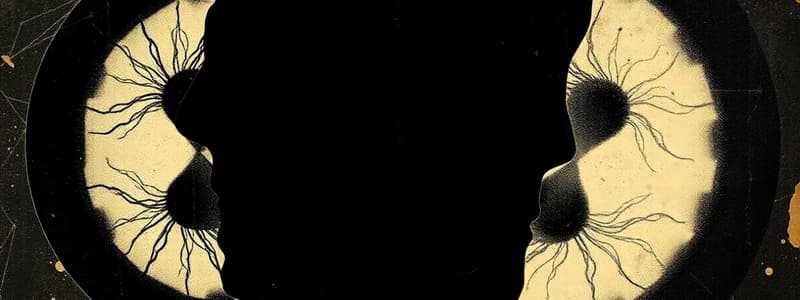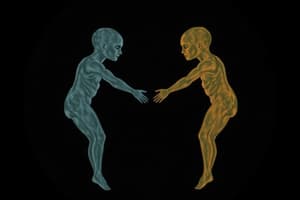Podcast
Questions and Answers
During which phase of meiosis do homologous chromosomes pair up and crossing over occur?
During which phase of meiosis do homologous chromosomes pair up and crossing over occur?
- Prophase II
- Prophase I (correct)
- Anaphase II
- Metaphase I
What is the significance of the reduction in chromosome number during meiosis?
What is the significance of the reduction in chromosome number during meiosis?
- It increases the chromosome number in the offspring.
- It results in identical daughter cells.
- It maintains the same chromosome number in each generation after sexual reproduction. (correct)
- It leads to genetic mutations and abnormalities.
In spermatogenesis, where does meiosis occur, and what is the result?
In spermatogenesis, where does meiosis occur, and what is the result?
- Ovaries, resulting in one viable egg cell.
- Testes, resulting in one viable sperm cell.
- Ovaries, resulting in four viable egg cells.
- Testes, resulting in four viable sperm cells. (correct)
What is the main difference between Anaphase I and Anaphase II?
What is the main difference between Anaphase I and Anaphase II?
What is interkinesis and why is it important?
What is interkinesis and why is it important?
Oogenesis starts before birth in females but pauses at which specific stage of meiosis?
Oogenesis starts before birth in females but pauses at which specific stage of meiosis?
What cells does meiosis begin in?
What cells does meiosis begin in?
What is the role of spindle fibers in Metaphase I?
What is the role of spindle fibers in Metaphase I?
Why is meiosis also known as reduction division?
Why is meiosis also known as reduction division?
When does spermatogenesis start and end?
When does spermatogenesis start and end?
What is the immediate result of Telophase I in meiosis?
What is the immediate result of Telophase I in meiosis?
During what stage of meiosis are sister chromatids separated?
During what stage of meiosis are sister chromatids separated?
If a diploid cell with 20 chromosomes undergoes meiosis, how many chromosomes will each daughter cell have after both Meiosis I and Meiosis II are complete?
If a diploid cell with 20 chromosomes undergoes meiosis, how many chromosomes will each daughter cell have after both Meiosis I and Meiosis II are complete?
What would be the most likely outcome if homologous chromosomes failed to pair during Prophase I?
What would be the most likely outcome if homologous chromosomes failed to pair during Prophase I?
How does the role of spindle fibers differ between Metaphase I and Metaphase II?
How does the role of spindle fibers differ between Metaphase I and Metaphase II?
Which of the following events contributes most significantly to genetic variation in meiosis?
Which of the following events contributes most significantly to genetic variation in meiosis?
What is the main difference between spermatogenesis and oogenesis regarding the final products of meiosis?
What is the main difference between spermatogenesis and oogenesis regarding the final products of meiosis?
At what specific stage of oogenesis does the process typically resume after being paused at Prophase I?
At what specific stage of oogenesis does the process typically resume after being paused at Prophase I?
How does interkinesis differ from interphase?
How does interkinesis differ from interphase?
Why is the timing and regulation of meiosis crucial for sexual reproduction?
Why is the timing and regulation of meiosis crucial for sexual reproduction?
If a scientist observes that a cell undergoing meiosis skips interkinesis, what is the most likely consequence for the resulting daughter cells?
If a scientist observes that a cell undergoing meiosis skips interkinesis, what is the most likely consequence for the resulting daughter cells?
A cell with 40 chromosomes undergoes meiosis. During Anaphase II, how many chromatids are present in each daughter cell?
A cell with 40 chromosomes undergoes meiosis. During Anaphase II, how many chromatids are present in each daughter cell?
What is the relationship between the number of chromosomes in a cell at the beginning of meiosis and the number of chromosomes in each of the resulting cells at the end of meiosis II?
What is the relationship between the number of chromosomes in a cell at the beginning of meiosis and the number of chromosomes in each of the resulting cells at the end of meiosis II?
How does the alignment of chromosomes during Metaphase I contribute to genetic diversity?
How does the alignment of chromosomes during Metaphase I contribute to genetic diversity?
A researcher introduces a drug that prevents the breakdown of the nuclear envelope during Prophase I. What is the most likely consequence of this drug?
A researcher introduces a drug that prevents the breakdown of the nuclear envelope during Prophase I. What is the most likely consequence of this drug?
If a mutation occurred such that cohesin proteins were non-functional only during meiosis, what specific meiotic process would be most directly affected?
If a mutation occurred such that cohesin proteins were non-functional only during meiosis, what specific meiotic process would be most directly affected?
What is the key significance of the pause in oogenesis at prophase I until puberty?
What is the key significance of the pause in oogenesis at prophase I until puberty?
Suppose a drug interfered with the function of the synaptonemal complex during Prophase I. What is the most likely result?
Suppose a drug interfered with the function of the synaptonemal complex during Prophase I. What is the most likely result?
How does the process of spermatogenesis contribute to genetic variation within a population?
How does the process of spermatogenesis contribute to genetic variation within a population?
If a cell begins meiosis with a mutation that prevents proper formation of the spindle fibers, what is the most likely outcome?
If a cell begins meiosis with a mutation that prevents proper formation of the spindle fibers, what is the most likely outcome?
Flashcards
What is Meiosis?
What is Meiosis?
Cell division that produces four daughter cells with half the number of chromosomes as the parent cell.
What are Germ Cells?
What are Germ Cells?
Specialized cells where meiosis begins; located in the testes (males) and ovaries (females).
What does Diploid Mean?
What does Diploid Mean?
Having the complete number of chromosomes (2n).
What Happens in Prophase I?
What Happens in Prophase I?
Signup and view all the flashcards
What is Synapsis?
What is Synapsis?
Signup and view all the flashcards
What is Crossing Over?
What is Crossing Over?
Signup and view all the flashcards
Anaphase I
Anaphase I
Signup and view all the flashcards
What is Interkinesis?
What is Interkinesis?
Signup and view all the flashcards
What is Spermatogenesis?
What is Spermatogenesis?
Signup and view all the flashcards
What is Oogenesis?
What is Oogenesis?
Signup and view all the flashcards
Meiosis
Meiosis
Signup and view all the flashcards
Germ Cells
Germ Cells
Signup and view all the flashcards
Diploid
Diploid
Signup and view all the flashcards
Prophase I
Prophase I
Signup and view all the flashcards
Synapsis
Synapsis
Signup and view all the flashcards
Crossing Over
Crossing Over
Signup and view all the flashcards
Interkinesis
Interkinesis
Signup and view all the flashcards
Spermatogenesis
Spermatogenesis
Signup and view all the flashcards
Oogenesis
Oogenesis
Signup and view all the flashcards
Study Notes
- Meiosis differs from mitosis in key ways.
- Meiosis begins in special diploid cells, called gametes, located in the testes (males) and ovaries (females), containing a complete set of chromosomes.
- During Interphase, DNA replicates, and the cell prepares for Meiosis I and Meiosis II.
Meiosis I
- During Prophase I, the nucleus and nucleolus break down, chromosomes thicken and become visible.
- Homologous chromosomes pair up, forming a tetrad, facilitating crossing over where genes jump between chromosomes.
- During Metaphase I, spindle fibers move tetrads to the cell's middle.
- During Anaphase I, homologous chromosomes separate and are pulled apart.
- During Telophase I, chromosomes reach the poles, nuclei reform, the cell divides, and two haploid cells are formed.
- After Telophase I, cells enter Interkinesis, similar to interphase but without DNA replication.
Meiosis II
- Prophase II involves the breakdown of the nucleus and nucleolus, making chromosomes visible.
- During Metaphase II, chromosomes are positioned in the middle of the cell.
- Anaphase II sees sister chromatids separate.
- Telophase II occurs when chromosomes reach the poles, nuclei reform, cells divide, and 4 haploid cells form.
- Due to the reduction in the number of chromosomes, meiosis is also known as reduction division.
Meiosis compared in males and females
- In males, meiosis is known as spermatogenesis, happening in the testes from puberty until death, resulting in four sperm cells.
- In females, meiosis is called oogenesis and occurs in the ovaries.
- Oogenesis starts before birth, pauses at prophase I, and resumes at puberty with one cell released monthly until menopause.
- Oogenesis results in one egg cell (ovum) and three polar bodies, which are non-viable.
- Fertilization, the fusion of two haploid gametes, creates a diploid zygote.
Studying That Suits You
Use AI to generate personalized quizzes and flashcards to suit your learning preferences.




